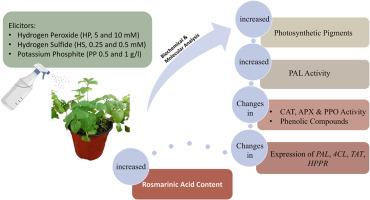过氧化氢、硫化氢和亚磷酸钾外源处理可促进迷迭香酸积累并调节茉莉关键生物合成基因的表达
IF 3.8
Q2 BIOTECHNOLOGY & APPLIED MICROBIOLOGY
引用次数: 0
摘要
柠檬香蜂草(Melissa officinalis L.)是一种著名的药用植物,传统上因其药理特性而受到重视。它的空中部分富含生物活性化合物,如迷迭香酸(RA),在植物防御系统中起关键作用,并有助于其抗痉挛,镇静和增强记忆的活动。然而,这些次生代谢物的天然浓度在药用植物中通常很低。本研究考察了外源激发子过氧化氢(HP, 5和10 mM)、硫化氢(HS, 0.25和0.5 mM)和亚磷酸钾(PP, 0.5和1 g/L)对光合色素积累、抗氧化酶活性、酚类含量、RA生成以及RA生物合成相关基因表达的影响。所有激发子均显著提高叶绿素a、b和类胡萝卜素水平。HP和HS处理显著提高了总酚和类黄酮含量。CAT和APX酶的活性随激发子类型和浓度的不同而变化。诱导通过增强PAL活性和调节关键生物合成基因(PAL、4CL、TAT和HPPR)的表达来增强RA积累。HS处理上调了苯丙氨酸和酪氨酸途径的基因,而HP对酪氨酸途径的刺激更有效。PP的激发导致不同浓度的基因表达差异。这些结果表明,HP、HS和PP可以调节关键的代谢和信号通路,从而促进RA的产生,并可能以安全和环保的方式提高马蹄草的药用价值。本文章由计算机程序翻译,如有差异,请以英文原文为准。

Exogenous application of hydrogen peroxide, hydrogen sulfide, and potassium phosphite enhances rosmarinic acid accumulation and modulates key biosynthetic gene expression in Melissa officinalis L
Melissa officinalis L. (lemon balm) is a well-known medicinal plant traditionally valued for its pharmacological properties. Its aerial parts are rich in bioactive compounds such as rosmarinic acid (RA), which play key roles in the plant defense system and contribute to its antispasmodic, sedative, and memory-enhancing activities. However, the natural concentrations of these secondary metabolites are typically low in medicinal plants. This study investigated the influence of exogenous elicitors, hydrogen peroxide (HP, 5 and 10 mM), hydrogen sulfide (HS, 0.25 and 0.5 mM), and potassium phosphite (PP, 0.5 and 1 g/L) on the accumulation of photosynthetic pigments, antioxidant enzyme activity, phenolic content, RA production, and the expression of RA biosynthesis-related genes. All elicitors significantly increased chlorophyll a, b, and carotenoid levels. Treatment with HP and HS notably elevated total phenolic and flavonoid contents. The activity of CAT and APX enzymes varied depending on the elicitor type and concentration applied. Elicitation enhanced RA accumulation by enhancing PAL activity and modulating the expression of key biosynthetic genes (PAL, 4CL, TAT, and HPPR). HS treatment upregulated genes in both phenylalanine and tyrosine pathways, whereas HP was more effective in stimulating the tyrosine pathway. PP elicitation led to differential gene expression depending on its concentration. These results demonstrate that HP, HS, and PP can modulate key metabolic and signaling pathways, thereby boosting RA production and potentially enhancing the medicinal value of M. officinalis in a safe and environmentally friendly manner.
求助全文
通过发布文献求助,成功后即可免费获取论文全文。
去求助
来源期刊

Biocatalysis and agricultural biotechnology
Agricultural and Biological Sciences-Agronomy and Crop Science
CiteScore
7.70
自引率
2.50%
发文量
308
审稿时长
48 days
期刊介绍:
Biocatalysis and Agricultural Biotechnology is the official journal of the International Society of Biocatalysis and Agricultural Biotechnology (ISBAB). The journal publishes high quality articles especially in the science and technology of biocatalysis, bioprocesses, agricultural biotechnology, biomedical biotechnology, and, if appropriate, from other related areas of biotechnology. The journal will publish peer-reviewed basic and applied research papers, authoritative reviews, and feature articles. The scope of the journal encompasses the research, industrial, and commercial aspects of biotechnology, including the areas of: biocatalysis; bioprocesses; food and agriculture; genetic engineering; molecular biology; healthcare and pharmaceuticals; biofuels; genomics; nanotechnology; environment and biodiversity; and bioremediation.
 求助内容:
求助内容: 应助结果提醒方式:
应助结果提醒方式:


